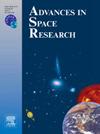基于回归模型的x射线脉冲星消噪变压器
IF 2.8
3区 地球科学
Q2 ASTRONOMY & ASTROPHYSICS
引用次数: 0
摘要
为了提高脉冲星观测剖面去噪算法的噪声抑制能力和适应性,提出了一种基于回归模型的变压器去噪方法。首先将脉冲星光子时间序列数据转换成脉冲剖面,然后进行标准化和数据增强。随后,Conv1d模块直接从观测到的脉冲星剖面和标准剖面中提取特征,将剖面上下文信息转换为中间语义特征。然后使用Transformer模块对剖面特征进行深度特征提取和回归分析,从而得到去噪的观测剖面。利用NICER望远镜的螃蟹和PSR B1509-58数据验证了所提出的方法。仿真实验表明,在蟹状脉冲星观测时间小于15 s、PSR B1509-58观测时间小于2500 s的情况下,所提方法的平均信噪比分别为18.7796 dB和10.1675 dB,平均Pearson相关系数分别为0.9921和0.9482,平均相位偏移分别为0.0417 ms和0.6639 ms。结果优于小波变换去噪和核回归去噪方法。本文章由计算机程序翻译,如有差异,请以英文原文为准。
Transformer based on regression model for the denoising of X-ray pulsar profiles
To improve noise suppression and adaptability in pulsar observation profile denoising algorithms, this paper proposes a method utilizing a transformer based on regression model. Initially, pulsar photon time-series data are transformed into pulse profiles, followed by standardization and data augmentation. Subsequently, the Conv1d module extracts features directly from observed pulsar profiles and standard profiles, converting profile contextual information into intermediate semantic features. The Transformer module is then employed for deep feature extraction and regression analysis on profile features, resulting in denoised observed profiles. Crab and PSR B1509-58 data from the NICER telescope are used to validate the proposed method. The simulation experiments demonstrate that under the conditions where the observation duration of the Crab pulsar is less than 15 s and that of PSR B1509-58 is below 2500 s, the proposed method achieves average signal-to-noise ratios of 18.7796 dB and 10.1675 dB, average Pearson correlation coefficients of 0.9921 and 0.9482, and average phase offsets of 0.0417 ms and 0.6639 ms, respectively. These results outperform those obtained using wavelet transform denoising and kernel regression denoising methods.
求助全文
通过发布文献求助,成功后即可免费获取论文全文。
去求助
来源期刊

Advances in Space Research
地学天文-地球科学综合
CiteScore
5.20
自引率
11.50%
发文量
800
审稿时长
5.8 months
期刊介绍:
The COSPAR publication Advances in Space Research (ASR) is an open journal covering all areas of space research including: space studies of the Earth''s surface, meteorology, climate, the Earth-Moon system, planets and small bodies of the solar system, upper atmospheres, ionospheres and magnetospheres of the Earth and planets including reference atmospheres, space plasmas in the solar system, astrophysics from space, materials sciences in space, fundamental physics in space, space debris, space weather, Earth observations of space phenomena, etc.
NB: Please note that manuscripts related to life sciences as related to space are no more accepted for submission to Advances in Space Research. Such manuscripts should now be submitted to the new COSPAR Journal Life Sciences in Space Research (LSSR).
All submissions are reviewed by two scientists in the field. COSPAR is an interdisciplinary scientific organization concerned with the progress of space research on an international scale. Operating under the rules of ICSU, COSPAR ignores political considerations and considers all questions solely from the scientific viewpoint.
 求助内容:
求助内容: 应助结果提醒方式:
应助结果提醒方式:


